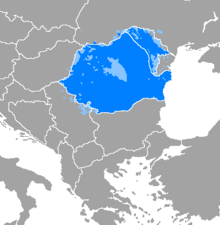Romanophone
| Romanian | |
|---|---|
| Daco-Romanian | |
| limba română | |
| Pronunciation | [roˈmɨnə] |
| Native to | Romania, Moldova |
| Ethnicity | Romanians (incl. Moldovans) |
|
Native speakers
|
24–26 million (2016) Second language: 4 million L1+L2 speakers: 28–30 million |
|
Indo-European
|
|
|
Early form
|
|
|
Latin (Romanian alphabet) Cyrillic (Transnistria only) Romanian Braille |
|
| Official status | |
|
Official language in
|
|
|
Recognised minority
language in |
|
| Regulated by |
Romanian Academy Academy of Sciences of Moldova |
| Language codes | |
| ISO 639-1 | ro |
| ISO 639-2 |
rum (B)ron (T)
|
| ISO 639-3 | |
| Glottolog | roma1327 |
| Linguasphere | 51-AAD-c (varieties: 51-AAD-ca to -ck) |

Blue: region where Romanian is the dominant language. Green: areas with a notable minority of Romanian speakers.
|
|

Distribution of the Romanian language in Romania, Moldova and surroundings.
|
|
Romanian (obsolete spellings Rumanian, Roumanian; autonym: limba română [ˈlimba roˈmɨnə] (![]() listen), "the Romanian language", or românește, lit. "in Romanian") is an East Romance language spoken by approximately 24–26 million people as a native language, primarily in Romania and Moldova, and by another 4 million people as a second language. It has official status in Romania and the Republic of Moldova. In addition, it is also one of the official languages of the European Union.
listen), "the Romanian language", or românește, lit. "in Romanian") is an East Romance language spoken by approximately 24–26 million people as a native language, primarily in Romania and Moldova, and by another 4 million people as a second language. It has official status in Romania and the Republic of Moldova. In addition, it is also one of the official languages of the European Union.
Romanian is a part of the Balkan-Romance group that evolved from several dialects of Vulgar Latin separated from the Western Romance during the 5th–8th centuries. To distinguish it within that group in comparative linguistics it is called Daco-Romanian as opposed to its closest relatives, Aromanian, Megleno-Romanian, and Istro-Romanian.
Romanian is traditionally known as Moldovan in Moldova, although the Constitutional Court ruled in 2013 that "the official language of the republic is Romanian".
...
Wikipedia
